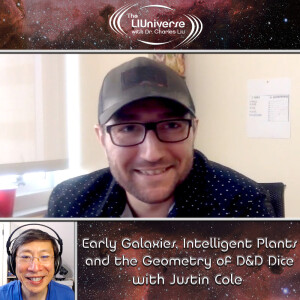
Saturday Apr 26, 2025
Early Galaxies, Intelligent Plants and the Geometry of D&D Dice With Justin Cole
Why is it so difficult to study the evolution of early galaxies? Are metallic D&D dice better than plastic ones? And can you have too many Pokémon tattoos? To find out, Dr. Charles Liu and co-host Allen Liu welcome Justin Cole, who is currently a grad student at Texas A&M studying the evolution of distant galaxies in pursuit of his PhD in Astronomy and Astrophysics.
As always, though, we start off with the day’s joyfully cool cosmic thing – the recent – and remarkable – discovery of four planets orbiting Barnard’s Star, a tiny star not much bigger than Jupiter with the highest measured proper motion of any star in our sky. Chuck and Justin discuss why the discovery of new exoplanets is so challenging, which leads to Justin explaining what he’s studying: galaxies in our universe that developed less than 1.5 billion years after the Big Bang – about 2.5 billion years before the birth of our own Milky Way Galaxy.
We’ve got a handle on what’s going on with our neighbors like the Andromeda Galaxy, but when it comes to early galaxies, we have a very limited range of wavelengths and scant data to study. This makes it harder to derive understandings of galactic evolution and whether they support or conflict with the standard model of physics.
Our first audience question comes from Ricardo, who asks, “What if we discover extraterrestrial plant life and find out it’s intelligent? Actually, what if we discover plants on Earth are intelligent? Would it be unethical to eat them?” After Chuck shares a little about Marvel’s intelligent, telepathic species of plants called the Cotati, and imitates Audrey 2 from Little Shop of Horrors, Justin weighs in on the ethics of eating intelligent plants and asks a critical question: Would we understand them enough to know? What would happen if we bit into a head of alien lettuce and it started screaming? The ensuing discussion is… tasty, albeit a little unsettling.
Our next question is from Thomasina, who asks, “I read that the Big Bang theory is in trouble – what does that mean? And did the Big Bang never happen?” Justin, who is an early universe guy, clarifies what’s going on here. We occasionally find galaxies that seem to be too big for the amount of time that they’ve had to grow. We’re also finding black holes that with our current instruments, also appear to be too big. In each case, we’re finding better ways to simulate these situations, and it’s not that they’re too big, or that the Big Bang isn’t supportable, it’s that we’re using tools that are calibrated to “nearby and today” that aren’t as good at helping us assess early galaxies.
Next up, Justin, who is getting ready to run a Dungeons & Dragons 5th Edition roleplaying session after the podcast recording, talks about using D&D Beyond to create his own campaigns (set in the World of Warcraft universe!). Chuck and Justin discuss the benefits of rolling metal dice, and Justin shows off a couple of his beautiful D20. Not to be outdone, Allen shares his 120-sided die, the largest die allowed by three dimensional Euclidean geometry in conventional space. Meanwhile, Chuck tells us the sad story of his old, worn plastic dice. As Allen points out, Chuck was in the hobby before it was cool! And as we run out of time, Justin shares his intention to get one Pokémon tattoo for every state he and his wife visit.
If you’d like to know more about what Justin’s up to, he suggests you Google “Justin Cole Astronomy” or “Justin Cole A&M.”
We hope you enjoy this episode of The LIUniverse, and, if you do, please support us on Patreon.
Credits for Images Used in this Episode:
- Size comparison between Jupiter, Barnard's Star, and the Sun. – Credit: Creative Commons.
- Diagram of evolution of the (observable part) of the universe from the Big Bang (left), the CMB-reference afterglow, to the present. – Credit: NASA/WMAP Science Team.
- Evolution of the gas density overlaid with a transparency mask to only visualize regions with significant ionizing radiation in the Thesan-1 simulation. – Credit: Harvard-Smithsonian Center for Astrophysics.
#TheLIUniverse #CharlesLiu #AllenLiu #SciencePodcast #AstronomyPodcast #JustinCole #Astronomy #Astrophysics #BarnardsStar #GalacticEvolution #BigBang #StandardModelofPhysics #ExtraterrestrialPlantLife #IntelligentLife #D&D #Pokemon #Tattoos
No comments yet. Be the first to say something!